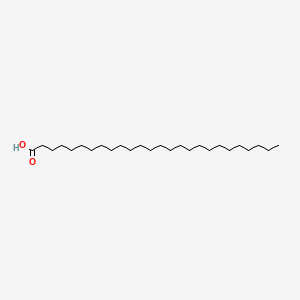| MeSH term | MeSH ID | Detail |
|---|---|---|
| Body Weight | D001835 | 333 associated lipids |
| Liver Diseases | D008107 | 31 associated lipids |
| Kidney Diseases | D007674 | 29 associated lipids |
| Leukemia P388 | D007941 | 43 associated lipids |
| Metabolism, Inborn Errors | D008661 | 46 associated lipids |
| Adrenoleukodystrophy | D000326 | 29 associated lipids |
| Diffuse Cerebral Sclerosis of Schilder | D002549 | 8 associated lipids |
| Arteriosclerosis | D001161 | 86 associated lipids |
| Metabolic Diseases | D008659 | 12 associated lipids |
| Adrenocortical Hyperfunction | D000308 | 3 associated lipids |
HEXACOSANOIC ACID
HEXACOSANOIC ACID is a lipid of Fatty Acyls (FA) class. Hexacosanoic acid is associated with abnormalities such as Adrenoleukodystrophy, Adrenal gland hypofunction and Chronic liver disease NOS. The involved functions are known as peroxisome targeting signal-2 binding activity, Oxidation, Demyelination, Mutation and Biosynthetic Pathways. Hexacosanoic acid often locates in peroxisome, Body tissue, Mitochondria, Membrane and Cytoplasm. The associated genes with HEXACOSANOIC ACID are ABCD1 gene, TRAM1 gene, GPX1 gene, SOD1 gene and SOD2 gene. The related lipids are Fatty Acids, Stearic acid, inositolphosphorylceramide, Very long chain fatty acid and Nonesterified Fatty Acids. The related experimental models are Knock-out.
Cross Reference
Introduction
To understand associated biological information of HEXACOSANOIC ACID, we collected biological information of abnormalities, associated pathways, cellular/molecular locations, biological functions, related genes/proteins, lipids and common seen animal/experimental models with organized paragraphs from literatures.
What diseases are associated with HEXACOSANOIC ACID?
HEXACOSANOIC ACID is suspected in Adrenoleukodystrophy, Adrenal gland hypofunction, Chronic liver disease NOS and other diseases in descending order of the highest number of associated sentences.
Related references are mostly published in these journals:
| Disease | Cross reference | Weighted score | Related literature |
|---|
Possible diseases from mapped MeSH terms on references
We collected disease MeSH terms mapped to the references associated with HEXACOSANOIC ACID
PubChem Associated disorders and diseases
What pathways are associated with HEXACOSANOIC ACID
There are no associated biomedical information in the current reference collection.
PubChem Biomolecular Interactions and Pathways
Link to PubChem Biomolecular Interactions and PathwaysWhat cellular locations are associated with HEXACOSANOIC ACID?
Visualization in cellular structure
Associated locations are in red color. Not associated locations are in black.
Related references are published most in these journals:
| Location | Cross reference | Weighted score | Related literatures |
|---|
What functions are associated with HEXACOSANOIC ACID?
Related references are published most in these journals:
| Function | Cross reference | Weighted score | Related literatures |
|---|
What lipids are associated with HEXACOSANOIC ACID?
Related references are published most in these journals:
| Lipid concept | Cross reference | Weighted score | Related literatures |
|---|
What genes are associated with HEXACOSANOIC ACID?
Related references are published most in these journals:
| Gene | Cross reference | Weighted score | Related literatures |
|---|
What common seen animal models are associated with HEXACOSANOIC ACID?
Knock-out
Knock-out are used in the study 'A key role for the peroxisomal ABCD2 transporter in fatty acid homeostasis.' (Fourcade S et al., 2009).
Related references are published most in these journals:
| Model | Cross reference | Weighted score | Related literatures |
|---|
NCBI Entrez Crosslinks
All references with HEXACOSANOIC ACID
Download all related citations| Authors | Title | Published | Journal | PubMed Link |
|---|---|---|---|---|
| Tomosaka H et al. | Lupeol esters from the twig bark of Japanese pear (Pyrus serotina Rehd.) cv. Shinko. | 2001 | Biosci. Biotechnol. Biochem. | pmid:11440139 |
| Yuan C et al. | Mychonastes afer HSO-3-1 as a potential new source of biodiesel. | 2011 | Biotechnol Biofuels | pmid:22040677 |
| Broz AK et al. | Plant neighbor identity influences plant biochemistry and physiology related to defense. | 2010 | BMC Plant Biol. | pmid:20565801 |
| Brites P et al. | Plasmalogens participate in very-long-chain fatty acid-induced pathology. | 2009 | Brain | pmid:19022859 |
| Jardim LB et al. | X-linked adrenoleukodystrophy: clinical course and minimal incidence in South Brazil. | 2010 | Brain Dev. | pmid:19269120 |
| Dhaunsi GS et al. | Very long chain fatty acids activate NADPH oxidase in human dermal fibroblasts. | 2005 Jan-Feb | Cell Biochem. Funct. | pmid:15565636 |
| Mika A et al. | Hyper-Elongation in Colorectal Cancer Tissue - Cerotic Acid is a Potential Novel Serum Metabolic Marker of Colorectal Malignancies. | 2017 | Cell. Physiol. Biochem. | pmid:28214830 |
| Aveldaño MI and Donnari D | Plasma phospholipid fatty acids in X-linked adrenoleukodystrophy. | 1996 | Clin. Chem. | pmid:8598113 |
| Harris HM et al. | Phytanic acid, pristanic acid, and very-long-chain fatty acid methyl esters measured simultaneously by capillary gas chromatography. | 1989 | Clin. Chem. | pmid:2702761 |
| Okahashi A et al. | Concentrations of very long-chain fatty acid in whole blood are associated with cardiovascular risk factors in children. | 2009 | Clin. Chim. Acta | pmid:19135040 |
